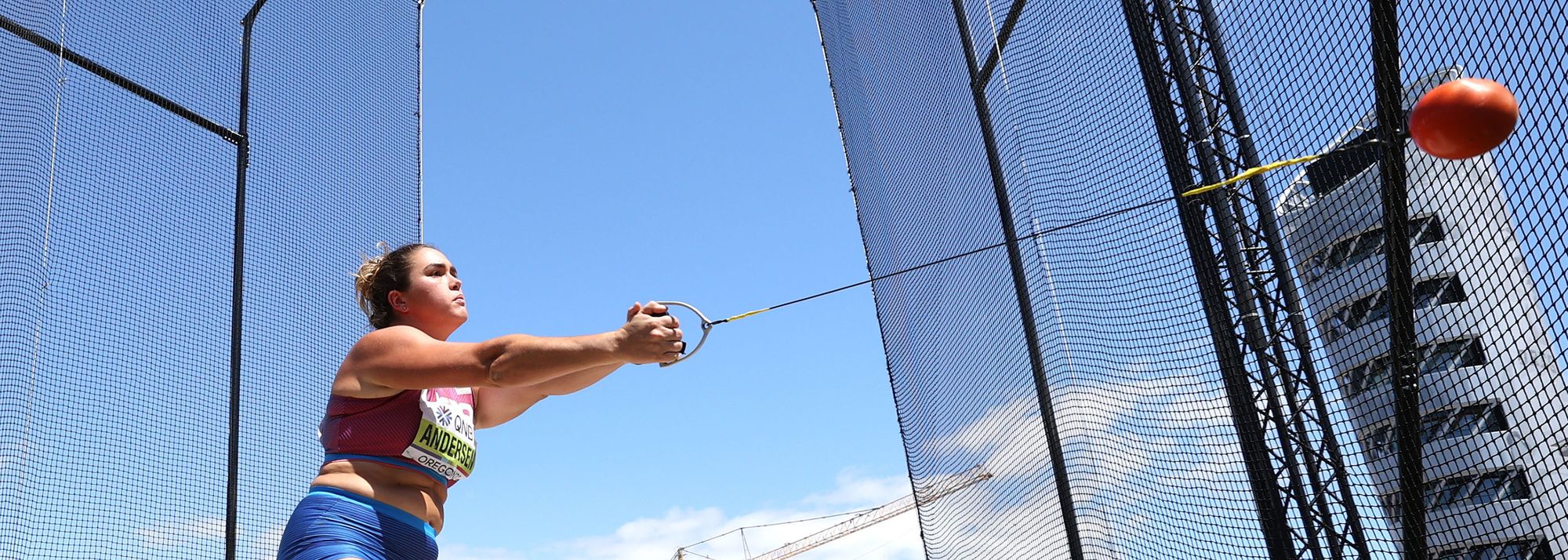USA's Brooke Andersen contests the hammer at the World Athletics Championships Oregon22 (© Getty Images)
The ascension of United State women’s throwers has been one of the biggest stories of the track and field season.
It continued Sunday when Brooke Andersen gave the U.S. its second straight World Athletics Championships gold medal in the hammer.
And it added another layer as Janee’ Kassanavoid finished third at WCH Oregon22 at the reimagined Hayward Field at the University of Oregon.
The United States entered the first World Athletics Championships on U.S. soil with the world leader in all four women’s throwing disciplines.
On Saturday, Chase Ealey became the first American woman to win a gold medal in the shot put at an outdoor World Athletics Championships. On Sunday, the U.S. won two medals in a women’s throwing event for the first time at an outdoor World Athletics Championships. The most accomplished American thrower, 2020 Olympic discus gold medalist Val Allman begins qualifying in that event on Monday.
“I think all of us are just coming into fruition,” said Andersen, who entered WCH Oregon22 as the world leader at 79.02m. “We’ve all put in a lot of hard work over the years, and I think it’s now starting to show.”
Only DeAnna Price, who won the 2019 World Athletics Championships gold medal in hammer, is ahead of Andersen on the all-time U.S. list. Andersen is also the fourth-ranked thrower in world history.
Andersen was third behind Canada’s Camryn Rogers and Kassanavoid before she finished the competition with the three longest throws of the day to win.
“I knew I could hit 77 (meters) today just the way practices have been trending,” Andersen said. “I actually thought that was going to come on the first three, and then I think I was just trying a little too hard and maybe a couple of nerves got to me a little bit in the first three.
“The last three I was able to let it rip in a sense and just have fun with it. It’s really great when you’re able to do that in such a high-intensity comp.”
Andersen took the lead for good with her fourth-round throw of 77.42m, improved to 77.56m in the fifth round and closed the competition in grand style with a toss of 78.98m, just four centimeters off her personal best.
“Even though the first three throws didn’t go my way, I just tried to keep my head on and just try and control what I can control and work from there,” Andersen said. “I just feel super grateful and happy to achieve what I just did. I don’t think it’s officially hit home yet. I’m just very, very happy.”
Rogers, a three-time NCAA champion who just concluded her collegiate career at the University of California-Berkeley, took the lead on her third-round throw with a mark of 75. 52m. When Rogers was unable to surpass Andersen on her final throw, Andersen had the win sewed up but took one final throw anyway.
“After Camryn threw her last one, and I saw the number pop up on the board, I wanted to start crying,” Andersen said, “because I knew what had just happened, but the competitiveness in me was just like, ‘you still have another throw. You can throw farther.’ I knew I had one in tank, and I just wanted to get one last good one out of me.”
Kassanavoid missed qualifying for the 2020 Tokyo Olympics by one spot at last year’s U.S. Trials. She entered this season with a PR of 75.50m before improving it to 76.82m and then to 78.00m in becoming the No. 3 thrower in U.S. history and the No. 6 thrower in world history.
“To have this big scale of a meet and to come out with a third-place medal, I’m super happy," said Kassanavoid, who took the lead with her second-round throw of 74.86m and had two other throws past 74m.
“In the hammer, as anyone knows, it takes a long time to develop, you just have to be patient and trust the process. Train hard and those big numbers are going to come.”
Winning a medal with Andersen was important to Kassanavoid, who is of Native American descent.
“Brooke and I have both been competing against each other forever," Kassanavoid said. “We’re super best friends, so each of our journeys are truly special and to be here on American soil, on native land, is something super special for me.”
By Ashley Conklin











